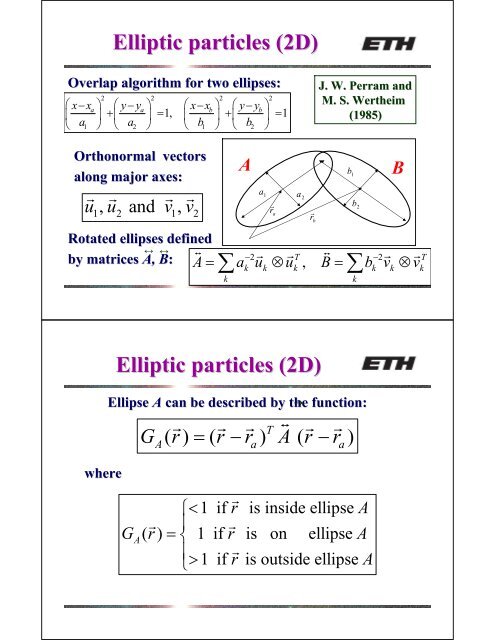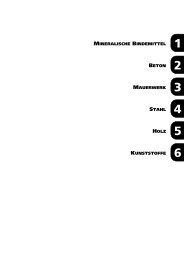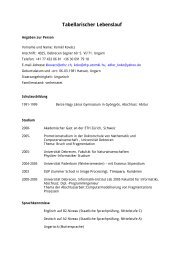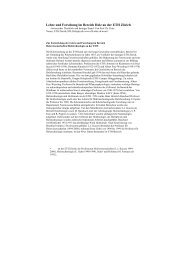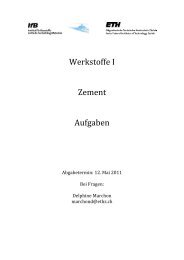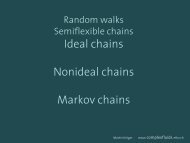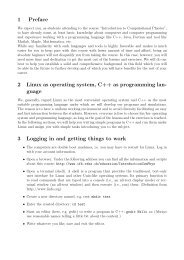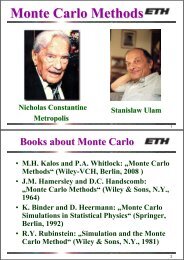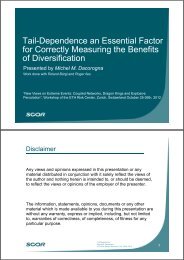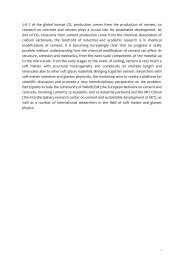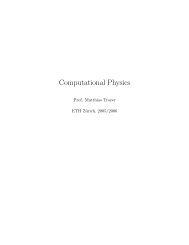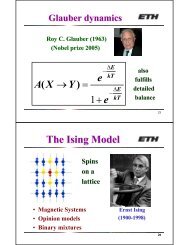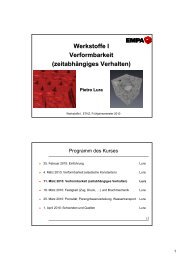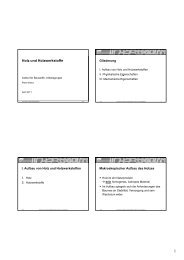You also want an ePaper? Increase the reach of your titles
YUMPU automatically turns print PDFs into web optimized ePapers that Google loves.
Elliptic particles (2D)Overlap algorithm <strong>for</strong> two ellipses:2 2 2 2xx ayy axx byyb 1, 1a a b b 1 2 1 2 J. W. Perram andM. S. Wertheim(1985)Orthonormal vectorsalong major axes: u , u and v , v1 2 1 2Rotated ellipses defined↔ ↔ by matrices A, B: B A a u u , B b v vkAa 1r aa 2r b 2 T2Tk k k k k kkb 1b 2BwhereElliptic particles (2D)Ellipse A can be describeddescribed by the function: T G ( r) ( r r ) A ( r r)A a a1 if r is inside ellipse A GA( r) 1 if r is on ellipse A 1 if r is outside ellipse A
Elliptic particles (2D)Define <strong>for</strong> λ [0,1] the function :G( r , ) G ( r ) (1 ) G ( r )AFind the global minimum over all r <strong>for</strong> fixed λ by Gr r( , ) 0This minimum r m (λ) describes a path from the center of Bto the center of A parametrized by λ [0,1]: 11 1 1rm( ) ra (1 ) A (1 )A B rab 11 1 1 rb B (1 ) A B rab,rab rb raBElliptic particles (2D)Inserting the minimum r m (λ)) into G (r, λ) definesthe overlap function S(λ) (non-negativenegative <strong>for</strong> λ [0,1]): S( ) (1 ) r(1 ) A B r , r r r T11 1 ab ab ab b aMaximize S(λ) ) <strong>for</strong> λ [0,1] → λ m , defines contact index: F( AB , ) (1 ) e(1 ) A Ber,r reT11 1 2m m r m m r ab roverlap if F(A,B) ) < 1, tangent if F(A,B) ) = 1, no contact if F(A,B) ) > 1
Elliptic particles (2D)Set F(A,B) ) to unity to find distance r* * at whichthe particles would just touch:→ overlap vector: * rer rab 21 (1 ) T (1 )1/2m m r m m r* 1 1r e A B e Obtain contact point: *r r pcpcElliptic particles (2D)example:Influence of elongationon packing fraction<strong>for</strong> elliptic particlesN. Berntsen, , 2001
Superellipsoids (3D)G.W. Delaney, P.W. Cleary (2009), F. Alonso-MarroquMarroquínGeneralized ellipsoid:m m m x y z 1a b ca,b,c: major axesshape parameter m(m m = 2: ellipsoid)here: a = b = 1, c = α→ elongated particles,platelets, , etc.Superellipsoids (3D)G.W. Delaney,P.W. Cleary (2009):1125 particles tostudy shape influenceon packing fraction.Advantage:good control of shapeby two parametersα and m
F F mg Ti Tiji xit1 xitvi( t)t Fivit1 vit tm 1 t t t ti i iiMD <strong>for</strong> rigid polygonsjij 1 t it tIiiT ii Y A n t nF n v n min v , F tij ijij ijljiv jtwo dimensionsF ijF ijv jjA = overlap areaPolygonal particlesArea detected by usingsimple geometry, e.g.area S 1 A i S 2 A j can bedecomposed in triangles.Many different types ofcontacts, when consider-ing polygonal particles.Some types have to betreated separately.
Polygonal particlesEdge-edgeedge contact: cut area has to be addeddiscontinuities can appear when particles move→ change particle area is added,such that total area changes continuously.Torque at contactParticles can rotate against each other:Torque acting against this rotation also depends onsize and shape of the contact area.
Polyhedra (3d)A.V. Potapov, , C. S. Campbell (1996):Huge number of different contact typesapproximately12000Delauney tetrahedraPolyhedra (3d)A.V. Potapov, , C. S. Campbell (1996)Fragmentation by impact
Rocks fallingon a pileusing thedilatationtechnique ofSerra (1986)M.A. Hopkins
Particles in Fluids• Sedimentation• Fluidized beds• Size segregation under shear• Hydraulic transport• Filtering• Saltation• Rheology of suspensionsEquation of motion of fluid u()x()and are velocity and pressure field of the fluid, and its density and dynamic viscosity.px ( u) 0 const tIncompressible Navier-Stokes equation:u 1 u( u) p utu0
Reynolds number ReReVhV is characteristc velocityh is characteristic length is dynamic viscosityRe > 1 is turbulent limit (Euler equation)Solvers <strong>for</strong> NS equation• Penalty method with MAC• Finite Volume Method (FLUENT)• Turbulent case: k-ε model or spectralmethod• Lattice Boltzmann Method• Discrete methods: DPD, SPH, SRD, LG…CFD = Computational Fluid Dynamics
One particle in fluide.g. . pull sphere through fluidno-slipcondition:v 0Γu fluidv 0movingboundaryconditioncreate shear in fluid : exchange momentumdrag <strong>for</strong>ce(Bernoulli‘s principle)Drag <strong>for</strong>ceF D dAstress tensoru ui jij xjxiijp η = is static viscosity
Homogeneous flowvRRe > 1 Newton‘s law: F D = 0.22π R 2 v 2general drag law:C D is the drag coefficient2 F D C D8 Re2Drag coefficient C D
Inhomogeneous flowIn velocity or pressure gradients: LiftLift <strong>for</strong>cesare perpendicular to the direction of the external flow,important <strong>for</strong> wings of airplanes.lift <strong>for</strong>ce:C L is lift coefficientMagnus effectwhen particle rotates: Magnusimportant <strong>for</strong> soccerMany particles in fluids•The fluid velocity field followsthe incompressible NavierStokes equations.• Many industrial processesinvolve the transport of solidparticles suspended in a fluid.The particles can be sand,colloids, polymers, etc.•The particles are dragged bythe fluid with a <strong>for</strong>ce:2 F D C D8 Re2simulating particlesmoving in a sheared fluid
Stokes limithydrodynamic interaction between the particles v M ( r r ) vi ij i j jjimobility-matrix<strong>for</strong> Re = 0 mobility matrix exactDynamics (Brady and Bossis)Stokesian Dynamicsinvert a full matrix only a few thousand particlesNumerical techniques12Calculate stress tensor directly by evaluatingthe gradients of the velocity fieldthrough interpolation on the numerical grid,e.g. using Chebychev polynomialsMethod of Fogelson and Peskin:Advect markers that were placed in theparticle and then put springs betweentheir new an their old position.These springs then pull the particle.
Sedimentation• Sedimentation ist the descent ofparticles in a fluid due to the action ofgravity.• The interaction between the particlesand the fluid is given by the conditionthat the velocity of the fluid on theentire surface of each particle is equalto the velocity of this particle.• Measure settling velocity, i.e.velocity of the upper front.• If particles are of different speciesthen one has several fronts.• Open question: size dependence ofthe density fluctuations.SedimentationGlass beadsdescendingin silicon oilusing penaltymethod withMAC gridcomparing experiment and simulation
Sedimentation velocitySedimentationof plateletsOblate ellipsoids descendin a fluid under the actionof gravity.This has applications inbiology (blood), industry(paint) and geology (clay).
Flow through a porous mediumimportant <strong>for</strong>oil recovery,filtration andfluidized bedstwo-dimensionalrealization byplacing randomlydisks that do notoverlap (RSA)FiltrationMassive tracerparticles ofdiameter d p ,velocity u pand density pare released.δyuxinertial impactionudirect interceptionDdiffusion = capture efficiencyStokes number:St : = D and St 0: = 0
Trajectories of particlesSt = 2.0610 -4St = 8.1210 -3Dependence on gravity


